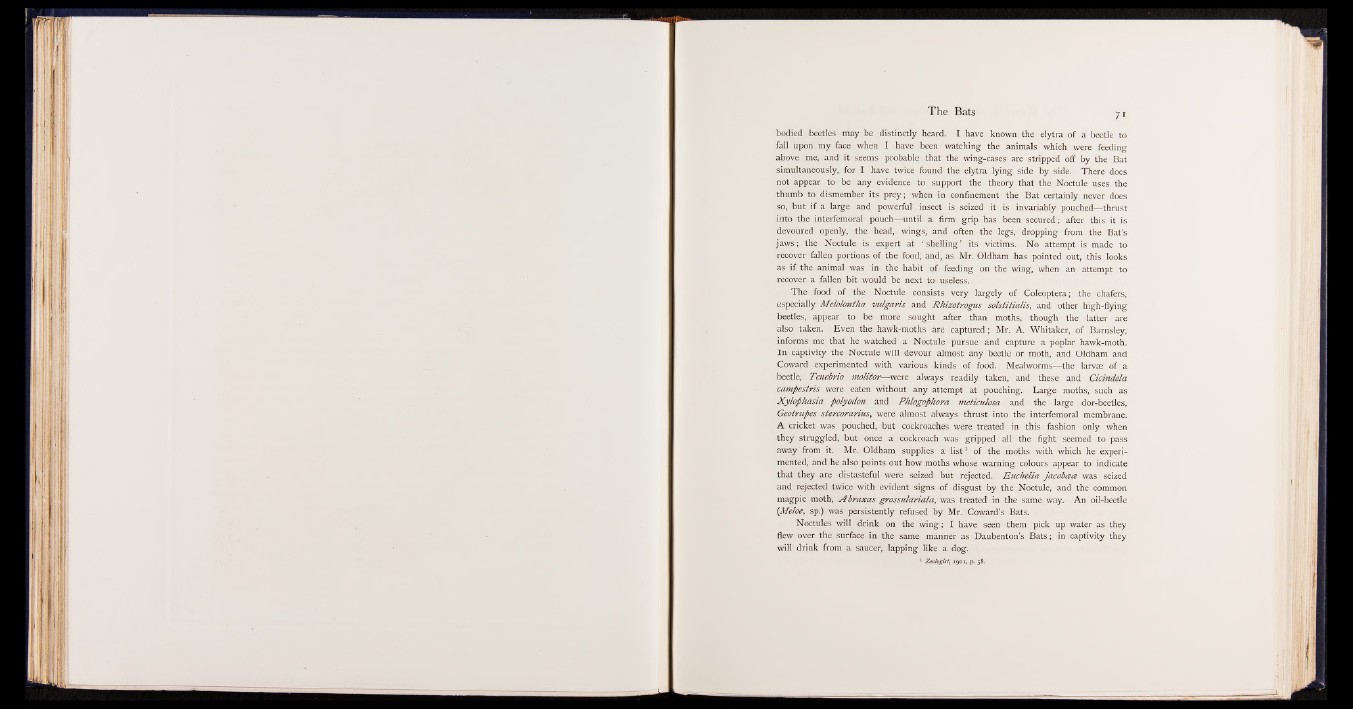
The Bats 7 r
bodied beetles may be distinctly heard. I have known the elytra of a beetle to
fall upon my face when I have been watching the animals which were feeding
above me, and it seems probable that the wing-cases are stripped off by the Bat
simultaneously, for I have twice found the elytra lying side by side. There does
not appear to be any evidence to support the theory that the Noctule uses the
thumb to dismember its prey; when in confinement the Bat certainly never does
so, but if a large and powerful insect is seized it is invariably pouched— thrust
into the interfemoral pouch— until a firm grip has been secured; after this it is
devoured openly, the head, wings, and often the legs, dropping from the Bat’s
jaws; the Noctule is expert at ‘ shelling ’ its victims. No attempt is made to
recover fallen portions of the food, and, as Mr. Oldham has pointed out, this looks
as if the animal was in the habit of feeding on the wing, 'when an attempt to
recover a fallen bit would be next to useless.
The food of the Noctule consists very largely of Coleoptera; the chafers,
especially Melolontha vulgaris and Rhizotrogus solstitialis, and other high-flying
beetles, appear to be more sought after than moths, though the latter are
also taken. Even the hawk-moths are captured; Mr. A. Whitaker, of Barnsley,
informs me that he watched a Noctule pursue and capture a poplar hawk-moth.
In captivity the Noctule will devour almost any beetle or moth, and Oldham and
Coward experimented with various kinds of food. Mealworms— the larvae of a
beetle, Tenebrio molitor—were always readily taken, and these and Cicindela
camftestris were eaten without any attempt at pouching. Large moths, such as
Xylophasia ftolyodon and Phlogophora meticulosa and the large dor-beetles,
Geotrupes stercorarius, were almost always thrust into the interfemoral membrane.
A cricket was pouched, but cockroaches were treated in this fashion only when
they struggled, but once a cockroach was gripped all the fight seemed to pass
away from it. Mr. Oldham supplies a list1 of the moths with which he experimented,
and he also points out how moths whose warning colours appear to indicate
that they are distasteful were seized but rejected. Euchelia jacobatce was seized
and rejected twice with evident signs of disgust by the Noctule, and the common
magpie moth, Abraxas grossulariata, was treated in the same way. An oil-beetle
(Meloe, sp.) was persistently refused by Mr. Coward’s Bats.
Noctules will drink on the wing; I have seen them pick up water as they
flew over the surface in the same manner as Daubenton’s Bats; in captivity they
will drink from a saucer, lapping like a dog.
1 Zoologist, 1901, p. 58.